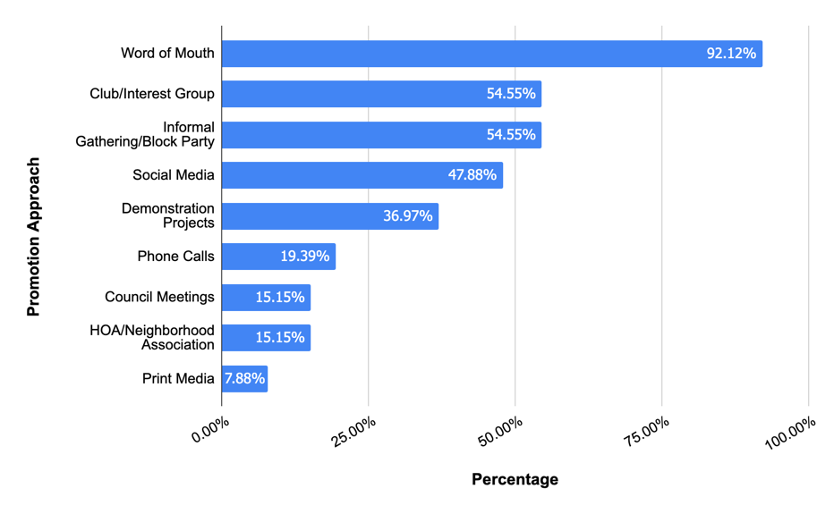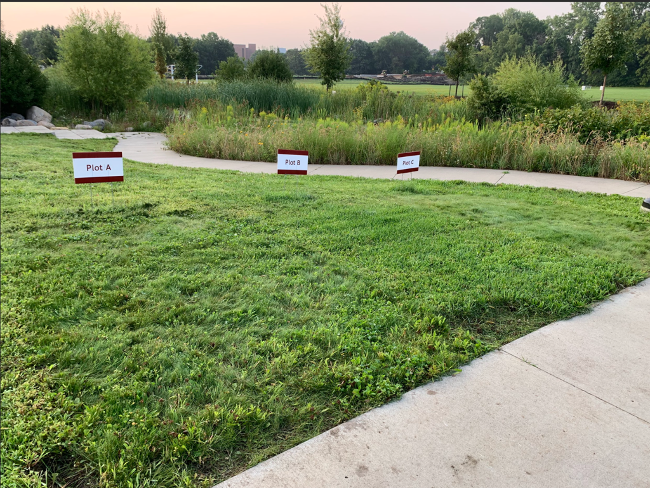By Meghan Klasic, Postdoc with University of Minnesota Dept. of Forest Resources & MSP LTER
Nearly everywhere you turn today, someone seems to be talking about pollinators. In October, AP News published an article about the impact of warming and habitat loss on pollinator numbers that might increase coffee and cocoa prices, while a BBC article discussed potential tech innovations to supplement honeybee pollination of crops. Across the Twin Cities, this year saw an unprecedented increase in the “No Mow May” campaign, a program in which cities forgo ordinance enforcement on grass height requirements and encourage residents to let their lawns grow “for the pollinators.”
This movement is hardly surprising; pollinators are a critical component of urban ecosystems (and vice versa). Urban areas can support diverse and abundant bee communities, while bees and other pollinators help urban agriculture keep up with increasing demand for locally produced food. Of course, pollinators also contribute to residential flower, herb, and garden aesthetics, while residential lawns potentially offer habitat and foraging for pollinators.
Residential landscapes makeup 41% of urban land in the United States, and as suburban areas expand, so does lawn coverage. This immense amount of lawn cover provides an opportunity to support pollinator species. Given the myriad benefits pollinators offer, it also begs the questions:1) What do residents think about “pollinator-friendly” lawns? and 2) What drives or motivates residents to use “pollinator-friendly” approaches when caring for their lawns?
The MSP LTER Policy and Advocacy team set out to answer these questions.

Figure 1. Photos (left to right): a pollinating bumblebee; self-heal (Prunella vulgaris), a pollinator-friendly plant that can be used as an alternative to traditional lawn plantings; and traditional turfgrass. Photos by: K. Nelson, M. Moncada, and D. Hansen.
With the help of colleagues on the MSP LTER Bee Lawn team, we reached out to residents who have expressed an interest in alternative lawn management with an extensive survey of questions on how they manage their lawns, their opinions of pollinators, what local rules and expectations their neighborhoods have for lawn management, and what ways (if at all) they promote “pollinator-friendly” lawn management in their community. We received 256 partial and complete surveys—a 53% response rate (a higher response rate than what is typical). If you were one of the respondents, thank you for your time!
What did we find in terms of pollinators and lawn management?
What is a “Bee Lawn”?
First, we asked respondents about their familiarity with bee lawns. About 38% of our respondents reported having a bee lawn, while 26% were unsure whether they had one. Bee lawns are a quintessential type of “pollinator-friendly” lawn. Bee lawns contain a mix of flowers that provide food for pollinators and grasses that reduce fertilizer and water input demands. Bee lawns require less fertilizer and pesticides to maintain and can adapt to mowing. Learn more about bee lawns through the University of Minnesota Bee Lab and through University of Minnesota Extension.
Priorities in Lawn Management
Survey respondents also reported making lawn management decisions based on options that attract and support pollinators like butterflies and bees. Climate change concern also drove management choices. However, respondents noted that attracting and supporting bats was a lower priority. Bats are a less understood—yet still critical—pollinator. In fact, more than 500 plant species rely on bat pollination! In addition to specific pollinator support, survey respondents noted that having lawns that match the neighborhood and/or are neat and orderly are some of the least important factors influencing how they manage their lawns.
Local Rules & Lawn Management
Next, we asked residents about local rules on lawn management. Local rules can limit or expand “pollinator-friendly” practices, so understanding what is out there and what residents are aware of are important pieces of the puzzle toward developing pollinator-friendly urban ecosystems. A little less than half of our respondents (47.3%) reported that their city has a rule (referred to as “ordinances”) about lawn management. In comparison, 39% of respondents were unsure if their city has an ordinance. City or municipal ordinances outline rules and regulations that residents must follow; breaking a rule often results in the city levying a penalty such as a warning or fine. In some cases, a city may take action; for example, city maintenance staff might mow a lawn and bill the resident for the work. If you are not sure whether your city has lawn management ordinances, take a few minutes to explore your city’s website to ensure you are not caught in an unfortunate situation.
Approaches to Lawn Management
Finally, we examined how residents promote approaches to “pollinator-friendly” lawn management. Of the 257 survey respondents, 165 reported promoting “pro-pollinator” lawn management in the past five years through nine different approaches (Figure 2). Overwhelmingly, survey respondents shared information by word of mouth (92.12%). They also shared information through clubs or interest groups (54.55%) and through informal get-togethers like block parties (54.55%). Far fewer respondents reported writing an article for print media (7.88%), promoting practices through HOA/neighborhood associations (15.15%), or attending local city council meetings (15.15%).
What [Resident] Characteristics are Associated with Choosing “Pollinator-Friendly” Lawns?
We are working to understand what motivates residents to promote “pollinator-friendly” lawn practices through these different approaches. Our preliminary results suggest that residents with annual incomes over $50K, with at least an undergraduate degree, and who have lived in their house for over 10 years, are more likely to promote “pollinator-friendly” practices. We also found that residents who are unsure whether their neighbors have lawn management expectations are more likely to promote “pollinator-friendly” lawn practices than residents who report that their neighbors do not have lawn management expectations. Understanding how residents promote “pollinator-friendly” lawn practices and what motivates them to promote these practices can help researchers target information, education, and other resources to appropriate audiences. Ultimately, we hope to ensure that all Twin Cities residents can benefit from a vibrant Twin Cities ecosystem that supports quality pollinators.

Figure 2. Percentage of survey respondents promoting “pro-pollinator” lawn practices through different approaches (n = 165).
Building on this initial survey, the Policy and Advocacy team recently launched a lawn alternatives exhibit at the Bell Museum with the help of the MSP LTER Bee Lawn team. The exhibit has three plots, planted with: traditional turfgrass, fine fescue (low fertilizer/water requirements), and a bee lawn mix (Figure 3). Visitors to the Bell can scan a QR code on a sign adjacent to the plots to share their preferences and opinions on the three plots. This exhibit will be at the Bell through December 2024, so head on out and share your thoughts with us!
Questions about our work? Visit the MSP LTER website’s Advocacy in Environmental Policies and Practices page!

Figure 3. Vegetation plot exhibit at the Bell Museum planted with: traditional turfgrass (Plot A), low input fine fescue (Plot B), and bee lawn mix (Plot C). Photo by: K. Griffin